Nissan Skyline
- See also: Nissan Skyline GT-R
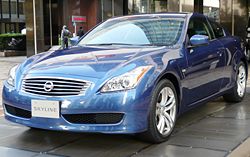 |
|
| Manufacturer | Prince Nissan |
|---|---|
| Production | 1957-present |
| Class | Compact (1957-1989) Mid-size (1990-Present) |
The Nissan Skyline is a mid-size car originally produced by the Japanese automaker Prince Motor Company starting in 1957 and later by Nissan after the two companies merged in 1966. It is available in either coupé, or sedan or wagon body styles. The current Skyline is sold in North America, South Korea, Taiwan, Australia, and the Middle East as the Infiniti G35.
Contents |
ALSI-1
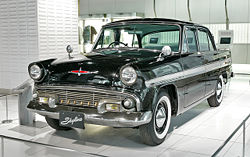 |
|
| Also called | Prince Skyline |
|---|---|
| Production | 1957-1963 33,759 units sold |
| Body style(s) | 4-door sedan 5-door station wagon 2-door coupe |
| Layout | FR layout |
| Engine(s) | 1.5 L GA-4 I4 1.9 L GB-30 I4 |
| Curb weight | ~1300 kg (~2866 lb) |
| Related | Prince Skyway |
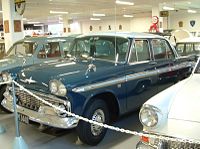
The first Skyline was introduced in April 1957,[1] under the Prince marque, and was marketed as a luxury car. It featured a 1.5 L (1482 cc) GA30 engine producing 44 kW (60 hp) @ 4,400 rpm.[2] It used a de Dion tube rear suspension and was capable of 140 km/h (87 mph). The car weighed around 1300 kg. Prince Skylines were produced as four door sedans and five door station wagons.
The Skyline also spawned pickup truck and van lines called the "Prince Skyway."
ALSI-2
The Skyline was updated with quad headlights for 1958.
This model was powered by a slightly altered 1.5 L engine known as the GA-4 OHV (1484 cc) producing about 70 hp (52 kW) @ 4400 rpm and was produced through 1961.
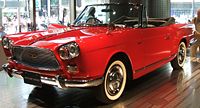
BLRA-3
The Skyline Sport featured hand-built Michelotti bodies in stylish coupe and convertible versions. These cars used the 1.9 L (1862 cc/113 in³) GB-30 engine, producing 96 hp (72 kW) and 113.5 ft·lbf (154 N m). While only a few hundred were built, Prince Motors had a very aggressive product placement group and they can be seen (along the company's mainstream models) in many Toho films of the early 1960s.
S50 or BLSID
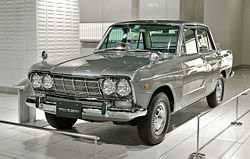 |
|
| Also called | Prince Skyline |
|---|---|
| Production | 1963-1968 114,238 units sold |
| Body style(s) | 4-door sedan |
| Layout | FR layout |
| Engine(s) | 1.5 L G-1 I4 2.0 L G-7 I6 (2000GT) 1.5 L G15 I4 (S57) |
| Transmission(s) | 5-speed manual |
In 1961 Fuji Precision Industries changed its name to Prince after the 1954 merger, and the S50 series was launched, which like its predecessor, came in sedan and wagon bodystyles. This was the second generation car, and became one of the more desirable cars in Japan. It was powered by the G-1 engine,[2] a 70 hp (52 kW) version of the old GA-4. A 1862 cc engine was also available, delivering 91 hp (68 kW).
In 1962, this model was restyled as the S21S series.
The S50 was further developed with new styling for 1963, and was sold in some markets with an A150 designation.
In 1966, Nissan and Prince merged and the S50 also appeared with Nissan Skyline badging. This model lasted in production through 1967.
S54
Prince created a racing GT Skyline in May 1964. It was based on the S54 and used the larger 6-cylinder G-7 engine from the Gloria S40, though the car needed an 8" extension to the wheelbase (all forward of the cowl/firewall) to provide space in the engine bay for the lankier in-line six. When it entered the 2nd Japanese Grand prix they hoped to win the GT-II class. Competitive against the Porsche 904, the Skyline managed 2nd through to 6th places.
Largely due to the success of the race vehicle, the Prince 2000GT (also called GT-A, GT-B, S54A and S54B) was released to the Japanese market. There were two versions produced:[2]
- S54A - 1988 cc G-7 single-carb I6, 105 hp (78 kW)
- S54B - 1988 cc G-7 triple-carb I6, 125 hp (94 kW)
The B model featured three Weber 40DCOE-18 carburetors, a limited slip differential, 5-speed manual transmission, and power brakes. Both the B and A used front disc brakes with dual pistons.
S57
The S50 Skyline was updated to become the S57 in 1967. It used a Nissan engine, the OHC 1.5 L (1487 cc) G15. At 88 hp (66 kW), it was the most-powerful engine in the Japanese 1500 cc class.
C10
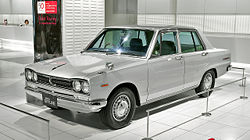 |
|
| Production | 1968-1972 310,447 units sold |
|---|---|
| Assembly | Oppama, Japan Tochigi, Tochigi, Japan |
| Body style(s) | 4-door sedan 5-door station wagon 2-door coupe |
| Layout | FR layout |
| Engine(s) | 1.5 L G15 I4 1.8 L G18 I4 2.0 L L20 I6 (2000GT) 2.0 L S20 I6 (GT-R) |
The C10 series of 1968, which began its development under Prince at the company's Opama R&D centre in the suburbs of Tokyo, was marketed with a Nissan badge. By the time the C10 went on sale, the Prince nameplate had been completely phased out on cars and trucks. The dealer network selling the cars became the Prince channel of Nissan, and the marketing group stayed at the Prince headquarters in Mita instead of moving to Nissan's headquarters in Ginza. The C10 Skyline was launched with Nissan's 1.5 L OHC G15 I4 like the S57. A 1.8 L G18 version was also available.
A station wagon variant was offered in this generation. A hardtop coupé was introduced in 1970.
2000GT-X

In 1970, the KGC10 2000GT-X received a 2.0 L (1998 cc) L20 I6 engine. The chassis was already designed to receive a straight six, to avoid the S54 extension problem. 120 hp (78 kW) was available from this new engine.
2000GT
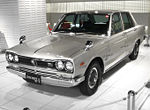
The following year, the GC10 2000GT received a 2.0 L (1998 cc) L20 I6 engine. The chassis was already designed to receive a straight six, to avoid the S54 extension problem. 105 hp (78 kW) was available from this new engine.
GT-R
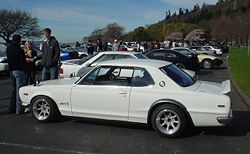
The first GT-R Skyline appeared in February 1969.[3] Called the PGC-10 (KPGC-10 for later coupé version) internally and Hakosuka (ハコスカ) by fans. Hako (ハコ) means Box in Japanese, and suka(スカ) is short for Skyline (スカイライン; Sukairain). It used the 2.0 L (1998 cc) S20 I6. This new DOHC engine produced 160 hp (118 kW, 180 N m), equal to the best sports cars of the time, and was similar to the GR8 engine used in the Nissan R380 racing car.
The GT-R began as a sedan, but a 2-door coupé version was introduced in March 1971. The cars were stripped of unnecessary equipment to be as light as possible for racing, and performed well at the track. The sedan racked up 33 victories in less than two years, and the coupé stretched this to 50 through 1972.[3]
The C10 raced against many cars including the Toyota 1600 GT5, Isuzu Bellett GTR, Mazda Familia (R100) & Capella (RX-2) - even Porsche. In late 1971 the new Mazda RX-3 became the GT-R's main rival. The GT-R managed a few more victories before the RX-3 ended the GT-R's winning streak. The GT-R was also a favorite of reckless street racers who roamed the streets at night at that time.
It is claimed that the art of drifting began among Japanese racers when they purposely engaged their hand brakes as a way to oversteer on their GT-Rs. One such driver who is famous for this was Kunimitsu Takahashi.
Models:
- 1500 - 1.5 L G15 I4, 95 hp (71 kW, 128 N m)
- 1800 - 1.8 L G18 I4, 105 hp (78 kW, 150 N m)
- 2000GT - 2.0 L L20E I6, 120 hp (90 kW, 167 N m)
- 2000GT-R - 2.0 L S20 I6, 160 hp (118 kW, 180 N m)
C110
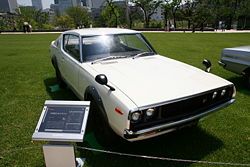 |
|
| Also called | Datsun K-Series |
|---|---|
| Production | 1972-1977 670,562 units sold |
| Assembly | Tochigi, Tochigi, Japan |
| Body style(s) | 4-door sedan 2-door coupe 5-door station wagon |
| Layout | FR layout |
| Engine(s) | 1.6 L G16 I4 1.8 L G18 I4 2.0 L L20B I4 2.0 L S20 I6 2.4 L L24 I6 |


The C110 generation was produced from 1972 through 1977.
For export in the 1970s, the C110 and GC110 Skyline was sold as the Datsun K-series, with models such as the Datsun 160K, 180K and Datsun 240K.
The body styles were, once again, four-door sedan, two-door hardtop coupé, and five-door station wagon. The C110 was more fussy in its styling than its predecessor, particularly so in wagon form, where unusually for a wagon design, no windows were fitted between the C and D pillars. The C110 was the first version to feature the round rear lights, typical of later Skyline designs.
The C110 Skyline was better known as the "Ken & Mary" or "Kenmeri" (ケンメリ) Skyline, stemming from the advertisement campaign in Japan at the time which featured a young couple (Ken and Mary) who relaxed and enjoyed the countryside in Ken and Mary's Skyline (ケンとメリーのスカイライン). The ads were highly successful and perhaps as a result the C110 was sold in very large numbers in Japan. It sold just as well in Australia (in a 2.4L 6-cylinder form, badged as "Datsun 240K") , though few survive today. There, the 240K was about the same price as a Ford Falcon GT or BMW 5 series, around $5000.
GT-R
The Nissan Skyline GT-R hardtop arrived in September 1972 but only lasted until March 1973, when Nissan ceased its production. The oil crisis saw many people preferring economy cars and high-performance sports cars were looked down upon. Nissan pulled out of Motor Racing, so there was no purpose to the GT-R. It was not officially exported anywhere, although Nissan contemplated exporting to Australia. Only 197 KPGC110 GT-Rs were ever sold in Japan,[4] through specialist Nissan Performance shops (before it was called NISMO). This was the last GT-R for 16 years until the BNR32 in 1989.
Models:
- 1600GT - 1.6 L G16 I4
- 1800GT - 1.8 L G18 I4
- 2000GT-X - 2.0 L L20E I6, 130 hp (96 kW, 172 N m)
- 2000GT-R - 2.0 L S20 I6, 160 hp (118 kW, 180 N m)
C211
| Also called | Datsun K-Series |
|---|---|
| Production | 1977-1981 539,727 units sold |
| Assembly | Tochigi, Tochigi, Japan |
| Body style(s) | 4-door sedan 2-door coupe 5-door station wagon |
| Layout | FR layout |
| Engine(s) | 1.6 L L16 I4 1.8 L L18 I4 2.0 L L20 I6 2.0 L L20ET I6 |

The succeeding C211 and GC211 of 1977 continued to split the Skyline range into basic and six-cylinder models, the latter with a longer front end. This line continued through 1981. The Datsun 240K/280K and 240C/280C variants continued for export.
A rare variant would be the wagon version, which had a unique styling treatment behind the rear doors, of a much smaller window than usual between the C and D pillars.
The GT-EX replaced the GT-R with a turbocharged engine, the L20ET. This was the first turbo engine to power a Japanese production vehicle . One notable aspect of the turbo versions was that they were not intercooled and there was no form of blowoff valve, only an emergency pressure release valve.
Models:
- 1600TI - 1.6 L L16 I4, 95 hp (71 kW, 132 N m)
- 1800TI - 1.8 L L18 I4, 115 hp (86 kW, 152 N m)
- 2000GT - 2.0 L L20B I6, 130 hp (97 kW, 167 N m)
- 2000GT-EX - 2.0 L L20ET turbo I6, 145 hp (108 kW, 206 N m)
R30
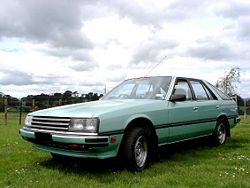 |
|
| Production | 1981-1985 406,432 units sold |
|---|---|
| Assembly | Tochigi, Tochigi, Japan |
| Body style(s) | 4-door sedan 2-door coupe 5-door hatchback 5-door station wagon |
| Layout | FR layout |
| Engine(s) | 1.8 L Z18S I4 1.8 L CA18E I4 2.0 L Z20E I4 2.8 L LD28 I6 2.0 L L20E I6 2.0 L L20ET I6 2.4 L L24E I6 2.0 L FJ20E I4 2.0 L FJ20ET I4 |
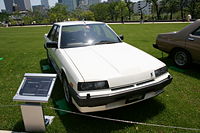
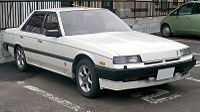
The names were brought into line with the home Japanese and worldwide markets with the launch of the R30 series in August 1981, which was built on a C31 Laurel platform. Unlike preceding generations, four and six-cylinder versions now shared a front end of the same length. The R30 was available as a two door hardtop coupe, a four door sedan, a five door hatchback (available only in the R30 generation) or a four door station wagon. In all, there were 26 variations of the R30 Skyline available.
All versions with the exception of the wagon were usually fitted with the four round tail lights that had become a regular feature to the Skyline's design. The wagon was the ugly duckling of the range, having different tail lights, headlights and no turbo or 6-cylinder versions available - it more closely resembled a Nissan Sunny than a Skyline. The two door coupe had pillarless doors and the unusual feature of roll-down quarter windows for the rear seat passengers (a styling feature of the previous C10, C110 and C211 coupes), while four door versions all had traditional framed windows.
Notably, configurations of the R30 sold in Australia and New Zealand were missing the traditional hotplate tail lights, instead opting for more conventional styling.
Various engine configurations were available, initially ranging from the top of the line 103 kW SOHC 6-cylinder turbo L20ET to the 4-cylinder Z18S and 6-cylinder RD28 diesel versions at the other end of the scale. The all-new 16-valve DOHC FJ20 engine debuted in late 1981, and was the first 4-cylinder engine by any Japanese manufacturer to employ more than two valves per cylinder (see below). Some of the top spec models featured adjustable suspension dampers that could be adjusted while driving, this was another first for mass produced JDM vehicles. Nissan Glorias and Laurels also used the L series engines as well as some diesel (Laurel only) variants.
The R30 range was facelifted in August 1983 with various changes across the board; for example four wheel disc brakes were now standard issue, instead of being optional for lower-spec models. Trim specifications were revised and the 4-cylinder Z18S engine was replaced with the newer CA18E. Upgraded interior trim, new front and rear bumpers, door-mounted wing mirrors (replacing the old 'hockey stick' fender mirrors) and smoked tail lights rounded out the look.
Paul Newman Version
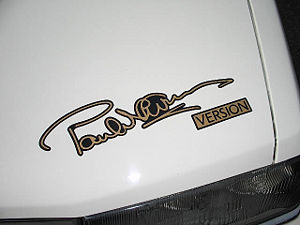
Also that year the Paul Newman Version R30 was released to commemorate the association between Nissan and the actor Paul Newman, who used to appear in promotional material as well as race for the company in the late 1970s - early 1980s. The Newman Skyline was simply a top spec GT-ES turbo with signature embroidery and decals, and is still sought after today amongst collectors in Japan.
RS
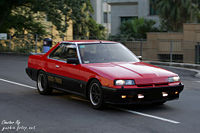
Although making about the same power as the L20ET-powered GT-ES models, the version of the Skyline initially known as the 2000RS was released in October 1981 as more of a stripped-down lightweight racer, without as many luxury extras included (quoted curb weight was only 1130 kg). These were equipped with the naturally aspirated 4-valve per cylinder DOHC FJ20E engine generating 110 kW of power at 6000 rpm and 181 N·m of torque at 4800 rpm. The official Nissan chassis designation for all FJ20-powered models was DR30.
In February 1983 the DR30 range received a significant boost in performance with the introduction of the turbocharged FJ20ET engine in the 2000RS Turbo. Front brakes were also significantly upgraded to cope with the power increase. Now with 140 kW of power at 6400 rpm and 225 N·m of torque at 4800 rpm on tap, the FJ20ET enjoyed new-found prestige as the most powerful Japanese production engine of its era.
Nissan sought to elevate the status of the DR30 Skyline as their new flagship model in light of this success, and it received a generous amount of changes to distinguish it from lesser Skyline models in August 1983. Interior equipment was significantly upgraded to now include electric windows, air conditioning and power steering as standard; gone were the days of the spartan, stripped-out race interior with the increased curb weight of around 1250 kg. But by far the most striking change to the RS was the new unique front end treatment, nicknamed Tekamen (鉄仮面) or Iron Mask by fans for its distinctive look. The headlights were considerably slimmer, and instead of a conventional grille the bonnet now sloped down to two narrow slits above a facelifted front bumper and airdam.[5] Turbocharged FJ20ET models were renamed RS-X Turbo while the N/A FJ20E model retained the RS moniker. The 2000 prefix was dropped.
Further changes were made in 1984, most notably the addition of an intercooler, revised compression ratios and turbocharger exhaust housing to the FJ20ET powered model, now known as the RS-X Turbo C and increasing output to 151 kW of power at 6400 rpm and 245 N·m of torque at 4400 rpm.
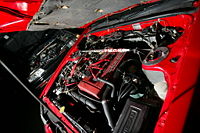
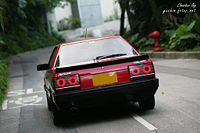
To this day the FJ20-powered R30 Skyline remains a cult car both at home and overseas (there are still dedicated "one make" drag racing events for this model in Japan), and is credited with rejuvenating the Skyline brand in the early 1980s. It also paved the way for the eventual re-introduction of the legendary GT-R badge, markedly absent since the end of C110 Skyline production in 1973.
The RS achieved moderate success in Australia in the mid-1980s, with drivers such as George Fury competing in (and winning) various touring car championships during that time.
Models: (Japan)
- 1800TI - 1.8 L Z18S SOHC I4, 105 hp (77 kW), later models 1.8 L CA18S SOHC I4, 105 hp (77 kW)
- 2000TI - 2.0 L CA20E SOHC I4
- 2000TI - 2.0 L Z20E SOHC I4
- 280D GT - 2.8 L LD28 SOHC I6 Diesel
- 2000GT and Passage - 2.0 L L20E SOHC I6
- 2000GT Turbo, Passage and Paul Newman Version - 2.0 L L20ET turbo I6, 140 hp (103 kW, 206 N m)
- RS - 2.0 L FJ20E DOHC I4, 150 hp (112 kW, 181 N m)
- RS-X and RS-X Turbo C - 2.0 L FJ20ET DOHC turbo I4, 190 to 205 hp (140 to 151 kW, 225 to 245 N m)
R31
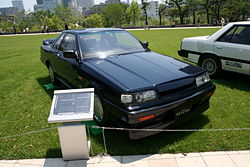 |
|
| Production | 1985-1989 309,716 units sold |
|---|---|
| Assembly | Tochigi, Tochigi, Japan |
| Body style(s) | 4-door sedan 4-door hardtop 2-door coupe 4-door station wagon |
| Layout | FR layout |
| Engine(s) | 1.8 L CA18I I4 2.0 L CA20E I4 2.0 L RB20E I6 2.0 L RB20ET I6 2.0 L RB20DE I6 2.0 L RB20DET I6 2.0 L RB20DET-R I6 3.0 L RB30E I6 2.8 L Diesel RD28 I6 |
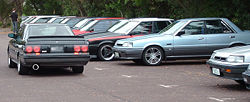
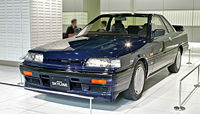
The R31 Skyline of 1986 was a natural evolution on the R30 shape. The design was slightly larger and squarer than previous Skylines. It was available as a Sedan, Hardtop sedan, Coupe and station wagon. Affectionately known as the "Seventhsu" or simply "7th Sukairain" by owners, due to it being the 7th generation Skyline.
The R31 Skyline introduced many new technologies and features. The HR31 was the first Skyline to be equipped with the new RB-series of engines. The R31 RB engines are often referred to as "Red Top" engines because of the red cam covers. There were three variants. The earliest series of DOHC RB engines used the NICS (Nissan Induction Control System) injection system with 12 very small intake runners, and a butterfly system to divide the intake ports in half for better low RPM performance. Later versions used ECCS (Electronically Concentrated Control System) engine management, discarded the twelve tiny runners for six much larger ones (though they retained twelve ports on the head, so there was a splitter plate), and received a slightly larger turbocharger. Nissan's RD28, a 2.8 straight-6 engine, introduced Diesel-power to the line-up. Another technological first for the R31 was the introduction of Nissan's proprietary 4-wheel steering system, dubbed HICAS (High Capacity Active Steering). The R31 series were also the only models in the Skyline family to feature a 4-door hardtop variation. These models were generally badged as the Passage GT.
The R31 Skyline was also produced in Australia, with a 3.0 L motor (RB30E) available in sedan or wagon form, as well as a four-cylinder version called the Nissan Pintara. The wagon had the same front style as the coupe and sedan—the only difference being that it lacked the four round brake lights that had been a consistent element of Skyline design (except for the r31 series one/two which had rectangular taillights with a solid bar through the centre which was also shared by the Pintara). These cars were manufactured in Australia due to the heavy import laws which made it expensive to bring cars into Australia.
29,305 R31 Skylines were also manufactured and sold in South Africa in 4-door sedan form between 1987 and 1992. These were the last Skylines seen in South Africa. Power came from either the RB30E 3.0 straight-6 motor, RB20E 2.0 straight-6 motor or the CA20S 4-cylinder powerplant.
GTS-R
The ultimate version of the R31 was the RB20DET-R powered HR31 GTS-R Coupe (800 units built for group A evolution). It had a reworked version of the normal RB20DET with a much larger turbocharger on a tubular steel exhaust manifold, as well as a much larger front mounted intercooler boosting power to a factory claimed 210 ps (154 kW), with racing versions making 460 hp (343 kW) in Group A trim.
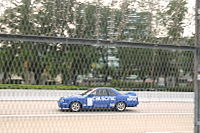
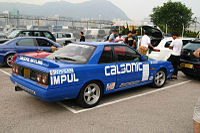
Models: 'Japan'
- 1800I - 1.8 L CA18(i) SOHC I4, 100 hp (75 kW)
- Passage GT-D - 2.8 L Diesel RD28 SOHC I6, 92 hp (68 kW, 173 N m)
- Passage GT - 2.0 L RB20DE DOHC I6, 155 hp (114 kW)
- Passage GT Turbo - 2.0 L RB20DET DOHC turbo I6, 180 hp (133 kW, 225 N m)
- GTS - 2.0 L RB20DE DOHC I6, 155 hp (114 kW)
- GTS Turbo - 2.0 L RB20DET DOHC I6, 180 hp (133 kW, 225 N m)
- GTS-X - 2.0 L RB20DET DOHC turbo I6, 190 hp (141 kW, 240 N m)
- GTS-R - 2.0 L RB20DET-R DOHC turbo I6, 210 hp (154 kW, 245 N m)
- GTS Autech - 2.0 L RB20DET-R DOHC turbo I6, 210 hp (154 kW, 245 N m)
'Australia'
- Pintara - 2.0 L CA20E I4, 102 hp (78 kW, 160 N m)
- GX, Executive, GXE, Silhouette, Ti - 3.0 L RB30E SOHC I6, 155 hp (114 kW, 247 N m)
- GTS1 - 3.0 L RB30E SOHC I6, 176 hp (130 kW, 255 N m)
- GTS2 - 3.0 L RB30E SOHC I6, 190 hp (140 kW, 270 N m)
'South Africa'
- 2.0GL, 2.0GLE - 2.0 L CA20S I4, 106 hp (78 kW, 163 N m)
- 2.0SGLi - 2.0 L RB20E SOHC I6, 115 hp (85 kW, 174 N m)
- 3.0SGLi - 3.0 L RB30E SOHC I6, 171 hp (126 kW, 260 N m)
R32
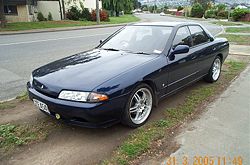

Skyline R32 GT-R
|
|
| Production | 1989-1994 296,087 units sold GT-R's Standard-40390 Nismo-560 vspec-1453 vspecII-1303 N1-228 |
|---|---|
| Assembly | Tochigi, Tochigi, Japan |
| Body style(s) | 4-door sedan 2-door coupe |
| Layout | Front engine, rear-wheel drive / four-wheel drive |
| Engine(s) | 1.8 CA18I I4 2.0 L RB20E I6 2.0 L RB20DE I6 2.5 L RB25DE I6 2.0 L RB20DET I6 2.6 L RB26DETT I6 (GT-R) |
| Transmission(s) | 5-speed automatic 5-speed manual |
| Curb weight | 1320 kg (type-m) 1430 kg (GT-R) |
| Fuel capacity | 60 litres (non GT-R), 75 litres (GT-R) |
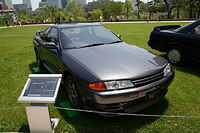
The HCR32 Skyline debuted in May 1989. It was available as either a 2-door coupe or 4-door sedan/saloon, all other bodystyles were dropped. The R32 featured several versions of the RB-series straight-6 engines, which had improved heads (the twelve port inlet was gone) and used the ECCS (Electronically Concentrated Control System) injection system. Also available were an 1,800 cc 4 cylinder GXi model. Most models had HICAS four-wheel steering, with the rear wheels being hydraulically linked to the front steering. The 2.5 litre version became one of the first cars made in Japan to feature a 5-speed automatic transmission. The GTS-t Type M included larger five-stud 16 in wheels, four piston front callipers and twin piston rears. ABS was optional (except for the GT-R), viscous LSD was standard on all turbo models and optional on all but the GXi. Nissan also produced 100 Australian models of the R32.
R32 Models:
- GXi Type-X - 1.8 L CA18i I4, 91 hp (67 kW)
- GTE Type-X - 2.0 L RB20E I6, 125 hp (93 kW, 152 N m)
- GTS Type-X, S, J - 2.0 L RB20DE I6 155 hp (115 kW, 154 N m)
- GTS-25 Type-X, S, XG - 2.5 L RB25DE I6, 180 hp (134 kW, 231 N m)
- GTS-t Type-M - 2.0 L RB20DET turbo I6, 212 hp (158 kW, 263 N m)
- GTS-4 - 2.0 L RB20DET turbo I6, 212 hp (158 kW, 263 N m)
- GTS-4 - 2.6 L RB26DE I6, 225 hp (169 kW, Autech Version - auto only
- GT-R - 2.6 L RB26DETT twin-turbo I6, 280+ hp (206 kW, 368 N m) also NISMO,N1, V-Spec, and V-Spec II variants.
GT-R
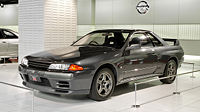
The GT-R returned with twin ceramic turbochargers, all-wheel steering, electronically controlled all wheel drive, and 280 hp (206 kW) at 6800 rpm.[6] The RB26DETT engine actually produced ~320 hp, but it was unstated due to the Japanese car makers' "gentlemen's agreement" not to exceed 206 kW (276 hp). The engine was designed for ~500 hp in racing trim,[7] and then muzzled by the exhaust, boost restriction, and ECU. The electronic boost control had a small physical restriction in the control lines. It was marked in yellow so the new owner could remove it and enjoy a safe factory boost increase.[8] After this increase the car would put out ~230 kW and could do 0-100 km/h in 4.7seconds and quarter mile in 12.8 seconds.
The GT-R had a significantly larger intercooler, larger brakes, and aluminium front guards and bonnet. Other distinguishing features include flared front and rear wheel arches. More supportive seats were fitted, and the turbo boost gauge and digital clock were removed from inside the instrument cluster. The clock was replaced with a torque meter that indicated how much torque was being delivered to the front wheels (0%-50%). Oil temp, voltage, and turbo boost gauges were fitted below the climate control.
The Porsche 959 was Nissan's target when designing the GT-R. The chief engineer, Naganori Itoh, intended to use the car for Group A racing, so the design specification was drawn up in conjunction with a copy of the Group A rules. The Nordschleife production car record at the time of development was 8'45" - set by a Porsche 944. Nissan test driver Hiroyoshi Katoh reset the record with a time of 8'20".[9] Best Motoring managed 8'22"38.[10]
The R32 GT-R dominated Japanese Touring Car Championship (JTCC), winning 29 races from 29 starts, taking the series title every year from 1989-1993.[11] It took 50 races from 50 starts from 1991-1997 (latterly R33) in the N1 Super Taikyu.
The R32 GT-R was introduced in to the Australian Touring Car Championship in 1990 and promptly ended the reign of the previously all-conquering Ford Sierra Cosworth, winning Bathurst 1000 classic in 1991 & 1992. This success led to the Australian motoring press nicknaming the car Godzilla due to it being a "monster from Japan". As Australia was the first export market for the car the name quickly spread. Such was GT-R's dominance that it is seen by some as a significant factor in the demise of Group A Touring Car racing, the formula being scrapped soon after. JTCC was similarly blighted by the R32 GT-R, and splintered soon after, leading to the switch to the Supertouring category and also indirectly to the GT500 category of today.
When originally designed, the homologation rulebook mandated 16" wheels, so that's what the GT-R got. This limited the size of the brakes, and the Nissan four pots weren't really up to competition use. A later change in rules allowed 17" wheels, so in February 1993 the GT-R V-spec (for Victory) emerged wearing 17" BBS mesh wheels(225/50/17) covering larger Brembo brakes. The clutch actuation changed from a push to a pull system, the car had the standard rear differential, the electronic rear differential did not show up until the R33 Vspec. A year later the V-Spec II appeared with a new sticker and wider tires(245/45/17).[12]
R33
| Production | 1993-1998 217,133 units sold |
|---|---|
| Assembly | Tochigi, Tochigi, Japan |
| Body style(s) | 4-door sedan 2-door coupe |
| Layout | Front engine, rear-wheel drive / four-wheel drive |
| Engine(s) | 2.0 L RB20E I6 2.5 L RB25DE I6 2.5 L RB25DE I6 2.5 L RB25DET I6 2.6 L RB26DETT I6 (GT-R) 2.8 L RBX-GT2 I6 (400R) |
| Transmission(s) | 4-speed automatic 5-speed manual 5-speed automatic |
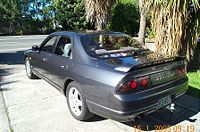
The R33 Skyline was introduced in August 1993. Slightly heavier than the R32, it is available in coupe and sedan bodystyles. All models now used a 6-cylinder engine. Nissan took the unusual step of down-grading the GTS model to have only the RB20E, while the twin-cam of the R32 GTS was discontinued along with the 2.0 L turbo RB20DET. As with the R32, all manual transmissions on the 2.5 litre non-turbo models were 5 speed, all 2 litre and turbo 2.5 litre automatic models were equipped with a 4-speed automatic transmission.
Some models came equipped with a new version of the HICAS 4-wheel steering system called Super HICAS. This computer controlled system was first used on the R32 GTR. Super HICAS used electric actuators to steer the rear, as opposed to the hydraulic HICAS.
As an option, an active limited slip differential was available instead of the standard viscous LSD. This new unit locked the rear differential if it detected that traction was lost by one of the wheels. A light on the dash also lit up if the LSD engaged. Active LSD came standard on all V-spec R33 GT-R Skylines and was also available on a certain amount of ECR33 GTS25t models, these can be identified by the A-LSD and SLIP lights on the tachometer.
The RB25DE and RB25DET engines also became equipped with NVCS (variable inlet cam phasing). NVCS equipped RBs have a bulge on the front of the cam cover. To celebrate their 40th anniversary, Nissan introduced a very rare 4 door GT-R. Two versions of the 4-door GT-R were available from Nissan's subsidiaries: the first was produced by Autech, and the second was a joint Autech/Nismo project.
A R33 based wagon was released in September 1996, called the Stagea. It had a different body style than the R33 and R34 and (with the exception of the RS FOUR & Autech variants) was only available with an automatic transmission. A common modification on the Stagea is to fit it with an R34 skyline front, in effect making a 4 door R34 wagon. The Stagea is the only four wheel drive manual transmission Nissan on the R33 platform with the RB25DET engine. Presumably, a 5 speed 4WD Skyline equipped with an RB25DET would have been too close in performance to the much more expensive GT-R. There was also an Autech Stagea, the 260RS released with full GT-R running gear, the RB26DETT engine, body kit, 17" BBS style alloys, GT-R instrumentation, and manual transmission.[13]
R33 models:
- HR33 GTS - 2.0 L RB20E SOHC I6, 130 PS (96 kW, 172 N m)
- ER33 GTS25 - 2.5 L RB25DE DOHC I6, 190 PS (140 kW, 231 N m)
- ENR33 GTS-4 - 2.5 L RB25DE DOHC I6, 190 PS (140 kW, 231 N m) 4WD
- ECR33 GTS25T - 2.5 L RB25DET DOHC turbo I6, 250 PS (184 kW, 294 N m)
1996
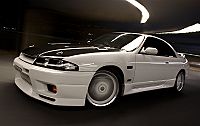
The R33 Skyline (Series 2) continued the concepts introduced in the R32. Driver and Passenger airbags became standard in 1996. As a result, pre-1996 models are barred from being imported into various countries for consumer road use as they do not meet the frontal impact standards. For the RB25DET engine the ignition system was also changed, with the ignition module no longer located on the cam covers and was instead replaced by smart ignition coils (Ignitor built into coil) and ECU. The RB25DET turbo was also given a nylon compressor wheel. Throughout the time the R33 was produced there were quite a number of different styled lights and bodykits fitted, the actual body/chassis underwent no changes. Among the cosmetic changes in the series 2 were, the headlights which tapered down more towards the grill and were fitted with improved reflectors, the grill (which was longer on the Series 1), the bonnet which had a re-shaped leading edge to fit the new lights and front bumper changing shape in the smallest amount to match the lower edge of the new headlights. Later models of the Series 2 also had the option of having an Active-LSD fitted. The R33 ceased production in March 1998 with the 40th Anniversary R33 Series 2.
GT-R
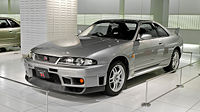
The BCNR33 GT-R version also had the same RB26DETT engine that the BNR32 was equipped with, although torque had been improved, due to changes in the turbo compressor aerodynamics, turbo dump pipe, and intercooler. The turbo core changed from a sleeve bearing to a ball bearing, but the turbine itself remained ceramic, except on N1 turbos (steel turbine, sleeve bearing). From the R33 onward, all GT-Rs received Brembo brakes.[14] In 1995 the GT-R received an improved version of the RB26DETT, the ATTESA-ETS all wheel drive system, and Super HICAS all-wheel steering.
A limited edition model was created in 1996, called the NISMO 400R, that produced 400 hp (298 kW) from a road-tuned version of Nissan's Le Mans engine.[15] A stronger six speed Getrag gearbox was used.
An R33 GT-R driven by Dirk Schoysman lapped the Nordschleife in less than 8 minutes. Though it was often said to be the first production car to break 8 minutes, the limited run Jaguar XJ220 had already achieved a 7'46" lap.[16] Other manufacturers had caught up since the R32 was released, and the R33 never dominated motorsport to the extent of the R32.
- GT-R - 2.6 L RB26DETT DOHC twin-turbo I6, 305 PS (224 kW, 375 N m) (advertised as 280 PS) 4WD
- GT-R LM - 2.6 L RB26DETT DOHC twin-turbo I6, 305 PS (224 kW) FR
- NISMO 400R - 2.8 L RBX-GT2 DOHC twin-turbo I6, 400 PS (294 kW, 478 N m) 4WD
- 4Dr.GT-R Autech.version - 2.6 L RB26DETT DOHC twin-turbo I6, 305 PS (224 kW, 375 N m) (advertised as 280 PS) 4WD
R34
 |
|
| Production | 1998–2002 64,623 units sold |
|---|---|
| Assembly | Tochigi, Tochigi, Japan |
| Body style(s) | 4-door sedan 2-door coupe |
| Layout | Front engine, rear-wheel drive / four-wheel drive |
| Engine(s) | 2.0 L RB20DE I6 2.5 L RB25DE I6 2.5 L RB25DET I6 2.6 L RB26DETT I6 |
| Transmission(s) | 4-speed automatic 5-speed manual 6-speed manual |
| Curb weight | 1540 kg (GT-R) 1410 kg (GT-T) |
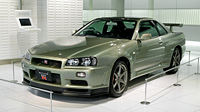
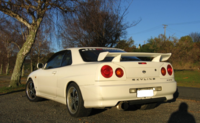
In May 1998, the HR/ER/BNR34 addressed many of the concerns over the change from the R32 to the R33, with more emphasis on sportiness, and marked the introduction of the more fuel-efficient and environmentally-friendly RB25DET NEO engine. The RB20E engine was discontinued in the R34 base model (GT), and the RB20DE, after last being used in the R32 Skyline, was reintroduced in updated NEO guise. The R34 GT powered by the RB20DE NEO, coupled with a 5-speed gearbox, became the most fuel-efficient straight-6 Skyline to date (of any shape). It was not the most fuel-efficient straight-6 of its time though; the 1998 Toyota Supra had better reported fuel economy. The 5-speed automatic transmission available on some models in the previous two shapes were discontinued. In its place, Nissan produced a 4-speed Tiptronic transmission for all of the automatic versions.
Models:
- GT - 2.0 L RB20DE NEO I6, 155 ps (114 kW)
- 25 GT, GT-X, GT-V - 2.5 L RB25DE NEO I6, 200 ps (147 kW)
- GT-FOUR - 2.5 L RB25DE NEO I6, 200 ps (147 kW) 4WD
- GT-T - 2.5 L RB25DET NEO turbo I6, 280 hp (206 kW, 343 N m)
GT-R
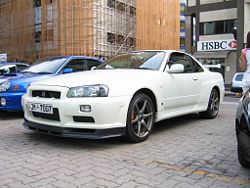
The GT-R reappeared in 1999, with a revised chassis and other updates. The R34 turbos received a ball bearing core. The R34 N1 turbos had a metal exhaust wheel, and ball bearing center section. A stronger 6-speed Getrag gearbox was used. The turbo outlet pipes were changed from cast to formed metal outlets. The intercooler had a temperature probe in the V-spec models.
Models:
- GT-R - 2.6 L RB26DETT twin-turbo I6, 332 PS (244 kW, 392 Nm) (advertised as 280)[17]
- GT-R V-Spec - Additional aero parts, brake ventilation ducts, diffuser.
- GT-R V-Spec II - As above + carbon fibre bonnet with NACA duct.
- GT-R N1 - Blueprinted N1 motor, no A/C, no stereo, no rear wiper, basic interior trim. (only 45 made)
- GT-R M-Spec - Leather interior, softer suspension with "Ripple Control" dampers, heated seats.
- GT-R V-Spec II Nür - As above V-Spec II + N1 motor, 300 km/h speedo. (only 750 made)
- GT-R M-Spec Nür - As above M-Spec + N1 motor, 300 km/h speedo. (only 250 made)
- GT-R NISMO R-tune
- GT-R NISMO Z-tune - 2.8 L (bored and stroked) RB26DETT Z2 twin-turbo I6, 500 PS (368 kW, 540 Nm) Z1 and Z2 (Only 20 made)
V35
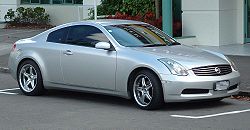 |
|
| Also called | Infiniti G35 |
|---|---|
| Production | sedan: 2001-2006 coupe: 2001-2007 |
| Assembly | Tochigi, Tochigi, Japan |
| Body style(s) | 4-door sedan 2-door coupe |
| Layout | Front engine, rear-wheel drive / four-wheel drive |
| Platform | Nissan FM platform |
| Engine(s) | 2.5 L VQ25DD V6 3.0 L VQ30DD V6 3.5 L VQ35DE V6 |
| Transmission(s) | 5-speed automatic 6-speed manual |
| Wheelbase | 2850 mm (112.2 in) |
| Length | 4630 mm (182.2 in)(coupe) 4735 mm (186.5 in) (sedan) |
| Width | 1815 mm (71.5 in) (coupe) 1750 mm (69 in) (sedan) |
| Height | 1390 mm (54.8 in) (coupe) 1465 mm (57.7 in) (sedan) |
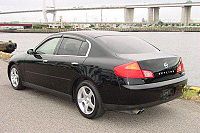
The 11th generation (V35) Nissan Skyline, introduced in June 2001, was based on Nissan's FM platform, shared with the Nissan 350Z. The Nissan Skyline used a front-midship engine (VQ35DE), rear-wheel drive layout[18] (all-wheel drive was available for the sedan) to achieve a 52%/48% weight distribution. The V35 was the first Skyline made for export to the United States. There it was sold under the company's luxury brand, Infiniti as the Infiniti G35.
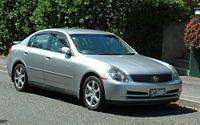
The V35 was a major turning point for the Skyline. There was no straight 6, no turbo, and no GT-R. Nissan put a slightly more powerful VQ35DE in the 350Z, and although the Skyline and the 350Z shared the same platform, the 350Z had additional bracing, underbody aero parts, and weighed 100 kg less.[19] Japanese tuners mostly ignored the V35 Skyline, the 2006 Tsukuba Super Lap Battle had not a single V35 entrant.[20] Tuners such as Mines, Amuse, Hosaka, Garage Defend, M Speed, Nagisa, MCR, HKS, & Top Secret continued developing R32-R34 GT-Rs. Top Secret did tune a V35, but they replaced the VQ35DE with a VK45DE V8 Twin Turbo.[21] Signal USA entered a V35 in Formula D, replacing the VQ35DE with an SR20DET.[22]
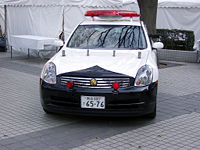
Models:
- 250GT - 2.5 L VQ25DD V6, 215 hp (158 kW, 270 N m)
- 250GT Four - 2.5 L VQ25DD V6, 215 hp (158 kW, 270 Nm) 4WD
- 300GT - 3.0 L VQ30DD V6, 260 hp (191 kW, 324 N m)
- 350GT-8 - 3.5 L VQ35DE V6, 272 hp (200 kW, 353 N m)
- 350GT Coupe - 3.5 L VQ35DE V6, 280 hp (206 kW, 363 N m)
V36
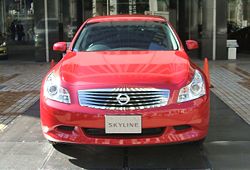 |
|
| Also called | Infiniti G35 Infiniti G37 |
|---|---|
| Production | 2006-present (Japan) |
| Assembly | Tochigi, Tochigi, Japan |
| Body style(s) | 4-door sedan 2-door coupe 2-door convertible |
| Layout | Front engine, rear-wheel drive / four-wheel drive |
| Platform | Nissan FM platform |
| Engine(s) | 2.5L VQ25HR V6 3.5L VQ35HR V6 |
| Transmission(s) | 5-speed automatic 6-speed manual |
| Wheelbase | 2850 mm (112.2 in) |
| Length | 4750 mm (187.0 in) (sedan) |
| Width | 1775 mm (69.8 in) (sedan) |
| Height | 1455 mm (57.2 in) (sedan) 1470 mm (57.8 in)(xAWD sedan) |
| Related | Infiniti FX Infiniti M Nissan 350Z Infiniti G37 Infiniti EX |
The 12th generation Skyline appeared on 20 November, 2006.[23]
It was first available only as a 4-door sedan in Japan and was also sold in the USA as the 2007 Infiniti G35. It is equipped with either a VQ25HR 2.5 L V6 producing 165 kW or a VQ35HR 3.5 L V6 with 232 kW (HR is the designation of the 4th iteration of the VQ engine [as opposed to the DE suffix of the previous iterations] and stands for High Response and High Revolution). The 2.5 L is available as a 4-wheel drive variant as well.
On May 13, 2008, Nissan announced that a convertible variant of the Infiniti G37 (U.S Spec Skyline coupe) will be produced for the 2009 model year.
Models:
- 250GT - 2.5L VQ25HR V6, 225 PS (222 hp/165 kW), 268 N·m (198 lb·ft)
- 250GT FOUR - 2.5L VQ25HR V6, 225 PS (222 hp/165 kW), 268 N·m (198 lb·ft) 4WD
- 350GT - 3.5L VQ35HR V6, 315 PS (311 hp/232 kW), 365 N·m (269 lb·ft)
- 370GT - 3.7L VQ37VHR V6, 333 PS (328 hp/245 kW), 363 N·m (268 lb·ft)
250GT sedan
Transmission is 5-speed automatic on all model ranges. 4 wheel drive is standard on 250GT FOUR models.
250GT Type S was introduced in 2008 model year.
350GT sedan
Transmission is 5-speed automatic on all model ranges.
4-wheel active steering is available in Type S and Type SP as option.
370GT coupe
Introduced in 2008 model year, it is a Japanese version of Infiniti G37 coupe.
Transmission is 5-speed automatic on all model ranges, with 6-speed manual on Type S and Type SP.
18-inch wheels are used on base and 370GT Type P, while Type S and Type SP includes 19-inch wheels.Also voted car of the year in 2007.
50th Limited
It is an option for 250GT Type P, 350GT Type P, 350GT Type SP, 250GT FOUR Type P, commemorating 50th year of Nissan Skyline.[24] The interior is marked with anniversary red leather seats, and serial numbered front glass. This package went on sale on 2008-03-31.[25]
R35
First introduced in Japan on 24 October 2007 at the Tokyo Motor Show, the Nissan GT-R (R35) was never officially named Skyline but is known as the successor to the Skyline GT-R. First sales started in 2008 as a 2009 model.[26] It was revealed at the Tokyo Motor Show, following the leak of the December issue of Motor Trend magazine that covered the future release of the model. Bearing a high resemblance to the Nissan GT-R Proto, the new GT-R keeps a shape that still bears the traits of its predecessors, but loses the "Skyline" moniker officially. The Nissan GT-R is equipped with the new VR38DETT V6 twin-turbo engine, breaking a 35 year old tradition of putting inline-sixes in GT-R models. The new GT-R still keeps certain technologies that made its predecessors famous, like an updated version of the ATTESA-ETS. The new R35 will be the first GT-R to be officially sold in the United States.
The new GT-R has also had a big success in Japanese racing series, then as the racing model the GT-R GT500.
Importation to foreign countries
The Skyline is a Grey import vehicle in the United States, Canada, United Kingdom, Australia & New Zealand, amongst others. This will likely end soon (at least with new models) since the GT-R will be launched globally at the end of 2008. It will have the same drivetrain with no detuning, so even privately importing a more powerful model will not be necessary (or even possible).
External links
- Official Nissan Skyline homepage (Japanese)
- Official Nissan Skyline R34 archived homepage (Japanese)
- Official Nissan GT-R Global Site
Notes
- ↑ "Prince Skyline" (in Japanese). Retrieved on 2006-09-22.
- ↑ 2.0 2.1 2.2 "Nissan Skyline History: 1st and 2nd Generation".
- ↑ 3.0 3.1 "Nissan Skyline 2000 GT-R KPGC10". JB car pages. Retrieved on 2008-10-26.
- ↑ "Nissan Skyline History: 3rd - 5th Generation".
- ↑ J's Tipo Magazine. June 1997.
- ↑ "R32 Nissan Skyline GTR Review". JB car pages. Retrieved on 2008-10-26.
- ↑ Butler, Andy (2006). Skyline GT-R The Ultimate Japanese Supercar. Haynes. pp. pg. 25. ISBN 1-84425-105-5.
- ↑ Donnon, Martin et al. (2005). High Performance Imports 57. Express Motoring Publications. pp. pg. 91.
- ↑ Butler, Andy (2006). Skyline GT-R The Ultimate Japanese Supercar. Haynes. pp. pg. 21-33. ISBN 1-84425-105-5.
- ↑ Motoharu Kurosawa (Gan-San) et al. (2005). Best Motoring International, Nismo Beast Unleashed [DVD]. Zigzag Asia.
- ↑ Keiichi Tsuchiya et al. (2005). Best Motoring International, RB Japanese Muscle [DVD]. Zigzag Asia.
- ↑ Butler, Andy (2006). Skyline GT-R The Ultimate Japanese Supercar. Haynes. pp. pg. 36. ISBN 1-84425-105-5.
- ↑ Ellis, Ben et al. (2001). High Performance Imports 15. Express Motoring Publications. pp. pg. 74-78.
- ↑ "R33 Nissan Skyline GTR Review". JB car pages. Retrieved on 2008-10-26.
- ↑ "Nismo 400R". JB car pages. Retrieved on 2008-10-26.
- ↑ Nunn, Peter (December 2006). Wheels. Australia: ACP Magazines. pp. pg. 13.
- ↑ "R34 Nissan Skyline GTR Review & Specs". JB car pages. Retrieved on 2008-10-26.
- ↑ "V35 Nissan Skyline". JB car pages. Retrieved on 2008-10-26.
- ↑ Akihiko Nakaya et al. (2003). Best Motoring International, 350Z Shock [DVD]. Zigzag Asia.
- ↑ Carbonare, Dino Dalle et al. (2006). Jtuner 11. Future Publications. pp. pg. 8-18.
- ↑ Ellis, Ben et al. (2005). High Performance Imports 54. Express Motoring Publications. pp. pg. 42-48.
- ↑ Warne, Grant et al. (2005). High Performance Imports 62. Express Motoring Publications. pp. pg. 44-48.
- ↑ "Nissan Introduces All-New Skyline". Nissan Press Release (20 November 2006). Retrieved on 2006-11-26. "Nissan Motors"
- ↑ スカイライン セダンの期間限定車「50th Limited」を発売
- ↑ "新型スカイライン 「50th Limited」誕生".
- ↑ "Nissan GTR Reviews". Retrieved on 2008-10-26.
|
||||||||||||||||||||||||||||||